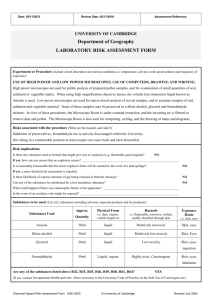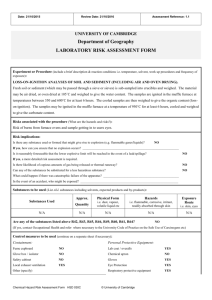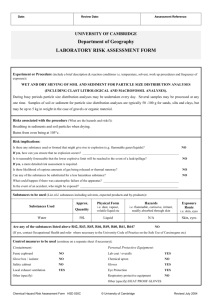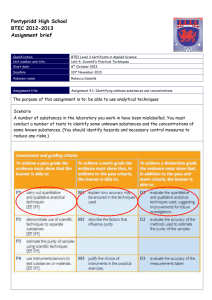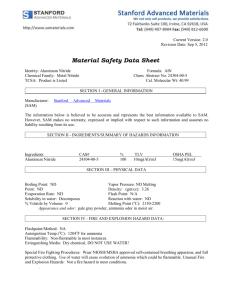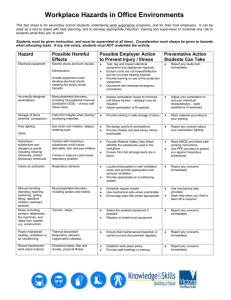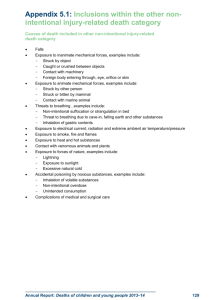Sampling and sediment description/handling
advertisement
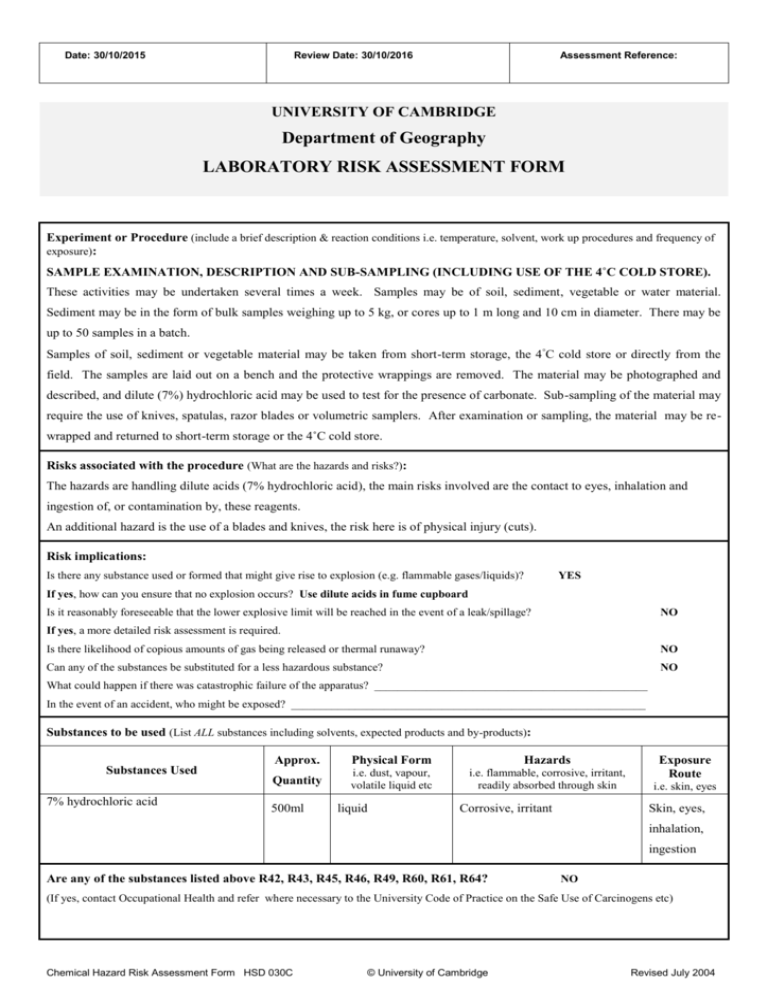
Date: 30/10/2015 Review Date: 30/10/2016 Assessment Reference: UNIVERSITY OF CAMBRIDGE Department of Geography LABORATORY RISK ASSESSMENT FORM Experiment or Procedure (include a brief description & reaction conditions i.e. temperature, solvent, work up procedures and frequency of exposure): SAMPLE EXAMINATION, DESCRIPTION AND SUB-SAMPLING (INCLUDING USE OF THE 4˚C COLD STORE). These activities may be undertaken several times a week. Samples may be of soil, sediment, vegetable or water material. Sediment may be in the form of bulk samples weighing up to 5 kg, or cores up to 1 m long and 10 cm in diameter. There may be up to 50 samples in a batch. Samples of soil, sediment or vegetable material may be taken from short-term storage, the 4C cold store or directly from the field. The samples are laid out on a bench and the protective wrappings are removed. The material may be photographed and described, and dilute (7%) hydrochloric acid may be used to test for the presence of carbonate. Sub-sampling of the material may require the use of knives, spatulas, razor blades or volumetric samplers. After examination or sampling, the material may be rewrapped and returned to short-term storage or the 4˚C cold store. Risks associated with the procedure (What are the hazards and risks?): The hazards are handling dilute acids (7% hydrochloric acid), the main risks involved are the contact to eyes, inhalation and ingestion of, or contamination by, these reagents. An additional hazard is the use of a blades and knives, the risk here is of physical injury (cuts). Risk implications: Is there any substance used or formed that might give rise to explosion (e.g. flammable gases/liquids)? YES If yes, how can you ensure that no explosion occurs? Use dilute acids in fume cupboard Is it reasonably foreseeable that the lower explosive limit will be reached in the event of a leak/spillage? NO If yes, a more detailed risk assessment is required. Is there likelihood of copious amounts of gas being released or thermal runaway? NO Can any of the substances be substituted for a less hazardous substance? NO What could happen if there was catastrophic failure of the apparatus? _______________________________________________ In the event of an accident, who might be exposed? _____________________________________________________________ Substances to be used (List ALL substances including solvents, expected products and by-products): Substances Used 7% hydrochloric acid Approx. Physical Form Hazards Quantity i.e. dust, vapour, volatile liquid etc i.e. flammable, corrosive, irritant, readily absorbed through skin 500ml liquid Corrosive, irritant Exposure Route i.e. skin, eyes Skin, eyes, inhalation, ingestion Are any of the substances listed above R42, R43, R45, R46, R49, R60, R61, R64? NO (If yes, contact Occupational Health and refer where necessary to the University Code of Practice on the Safe Use of Carcinogens etc) Chemical Hazard Risk Assessment Form HSD 030C © University of Cambridge Revised July 2004 Control measures to be used (continue on a separate sheet if necessary): Containment: Personal Protective Equipment: Fume cupboard NO Lab coat / overalls YES Glove box / isolator NO Chemical apron NO Safety cabinet NO Gloves YES Local exhaust ventilation NO Eye Protection YES Respiratory protective equipment NO Other (specify) Other (specify) N/A Are any additional controls required? (Consider nearby sources of ignition, formation of explosive atmospheres/mixtures, asphyxiation in confined spaces) Lab coat, gloves and eye protection are the minimum required personal protection for all reagent use. Disposal measures to be used during and after the procedure: (Also consider by-products and washings) 7% Hydrochloric Acid can be washed down the sink with copious amounts of water Emergency Procedures (emphasise any special hazards): Shutdown Procedures: N/A Action in the event of fire (type of fire extinguisher): Powder Action in the event of spillage or uncontrolled release: Don’t panic, this can be diluted with copious amounts of water and mopped up, if in doubt, vacate the laboratory and summon help. Emergency treatment for personnel in the event of contamination, exposure to fumes or other adverse effects Inhalation: Remove casualty to fresh air, summon first aid if needed. Ingestion: Do not induce vomiting. Immediately rinse mouth and drink plenty of water (200-300 ml). Get medical attention immediately! Skin contact: Flood skin with cool clean water and summon first aid. Eye contact: Irrigate with cool clean water for at least 20 minutes, summon first aid, send to A & E Unit at Addenbrookes Hospital. Name of assessor: Signature: Date: Name of co-signatory: (e.g. Supervisor / authorised deputy) Signature: Date: Note: This risk assessment should be reviewed at least annually and when there is any significant change in procedure. Chemical Hazard Risk Assessment Form HSD 030C © University of Cambridge Revised July 2004
